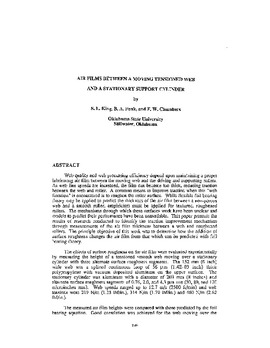| dc.contributor.author | King, S. L. | |
| dc.contributor.author | Funk, B. A. | |
| dc.contributor.author | Chambers, F. W. | |
| dc.contributor.other | International Conference on Web Handling (1993) | |
| dc.date.accessioned | 2019-11-04T19:56:14Z | |
| dc.date.available | 2019-11-04T19:56:14Z | |
| dc.date.issued | 1993-06 | |
| dc.identifier | oksd_icwh_1993_king | |
| dc.identifier.citation | King, S. L., Funk, B. A., & Chambers, F. W. (1993, June). Air films between a moving tensioned web and a stationary support cylinder. Paper presented at the Second International Conference on Web Handling (IWEB), Stillwater, OK. | |
| dc.identifier.uri | https://hdl.handle.net/11244/321664 | |
| dc.description.abstract | Web quality and web processing efficiency depend upon maintaining a proper lubricating air film between the moving web and the driving and supporting rollers. As web line speeds are increased, the film can become too thick, reducing traction between the web and roller. A common means to improve traction when this "web flotation" is encountered is to roughen the roller surface. While flexible foil bearing theory may be applied to predict the thickness of the air film between a non-porous web and a smooth roller, empiricism must be applied for textured, roughened rollers. The mechanisms through which these surfaces work have been unclear and models to predict their performance have been unavailable. This paper presents the results of research conducted to identify the traction improvement mechanism through measurements of the air film thickness between a web and roughened rollers. The principle objective of this work was to determine how the addition of surface roughness changes the air film from that which can be predicted with foil bearing theory. | |
| dc.description.abstract | The effects of surface roughness on the air film were evaluated experimentally by measuring the height of a tensioned smooth web moving over a stationary cylinder with three alternate surface roughness segments. The 152 mm (6 inch) wide web was a spliced continuous loop of 36 μm (1.4E-03 inch) thick polypropylene with vacuum deposited aluminum on the upper surface. The stationary cylinder was aluminum with a diameter of 203 mm (8 inches) and alternate surface roughness segments of 0.76, 2.0, and 4.3 μm rms (30, 80, and 170 microinches rms). Web speeds ranged up to 12.7 m/s (2500 ft/min) and web tensions were 219 N/m (1.25 lbf/in.), 314 N/m (1.79 lbf/in.) and 460 N/m (2.62 lbf/in.). | |
| dc.description.abstract | The measured air film heights were compared with those predicted by the foil bearing equation. Good correlation was achieved for the web moving over the smoothest surface only. The rougher surfaces did not produce air films that followed theory for the complete speed range. In some cases, the air films followed foil bearing theory at lower speeds but then became nearly constant and independent of speed at higher speeds, significantly below foil bearing predictions. The air films for the highest roughness surface were constant and independent of speed throughout the tested speed range, remaining far below the predictions of foil bearing theory. The reasons for this behavior and the implications for web-roller traction are discussed. | |
| dc.format | application/pdf | |
| dc.language | en_US | |
| dc.publisher | Oklahoma State University | |
| dc.rights | In the Oklahoma State University Library's institutional repository this paper is made available through the open access principles and the terms of agreement/consent between the author(s) and the publisher. The permission policy on the use, reproduction or distribution of the article falls under fair use for educational, scholarship, and research purposes. Contact Digital Resources and Discovery Services at lib-dls@okstate.edu or 405-744-9161 for further information. | |
| dc.title | Air films between a moving tensioned web and a stationary support cylinder | |
| osu.filename | oksd_icwh_1993_king.pdf | |
| dc.description.department | Mechanical and Aerospace Engineering | |
| dc.type.genre | Conference proceedings | |
| dc.type.material | Text | |
